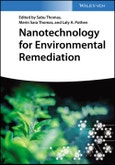Nanotechnology for Environmental Remediation
Comprehensive resource on using nanomaterials to alleviate environmental pollution
Contaminated land, soil and water pose a threat to the environment and health. These sites require immediate action in terms of assessing pollution and new remediation strategies. Nanotechnology for Environmental Remediation helps readers understand the potential of nanotechnology in resolving the growing problem of environmental contamination.
The specific aim of this book is to provide comprehensive information relating to the progress in the development of functional nanomaterials and nanocomposites which are used for the environmental remediation of a variety of contaminants. The work deals with the different aspects of nanotechnology in water, air and soil contamination and presents the recent advances with a focus on remediation. Core topics discussed in the work include: - Nanotechnology that can be used to engineer and tailor particles for specific environmental remediation applications - A big-picture conceptual understanding of environmental remediation methods for researchers, environmentalists and professionals involved in assessing and developing new nano-based strategies - A detailed approach towards the different remediation procedures by various nanomaterials such as metal nanoparticles, polymeric nanoparticles, carbon nanotubes, and dendrimers - The societal impact that nanotechnology has on the environment
Chemists and biotechnologists can use Nanotechnology for Environmental Remediation as a comprehensive reference work for thoroughly understanding this new type of technology and why it is so important when considering environmental remediation efforts. Due to the practical application of nanotechnologies, environmental organizations and agencies can also both utilize the work to explore new and more effective ways of doing things, both now and into the future as nanotechnology becomes more common.
Comprehensive resource on using nanomaterials to alleviate environmental pollution
Contaminated land, soil and water pose a threat to the environment and health. These sites require immediate action in terms of assessing pollution and new remediation strategies. Nanotechnology for Environmental Remediation helps readers understand the potential of nanotechnology in resolving the growing problem of environmental contamination.
The specific aim of this book is to provide comprehensive information relating to the progress in the development of functional nanomaterials and nanocomposites which are used for the environmental remediation of a variety of contaminants. The work deals with the different aspects of nanotechnology in water, air and soil contamination and presents the recent advances with a focus on remediation. Core topics discussed in the work include: - Nanotechnology that can be used to engineer and tailor particles for specific environmental remediation applications - A big-picture conceptual understanding of environmental remediation methods for researchers, environmentalists and professionals involved in assessing and developing new nano-based strategies - A detailed approach towards the different remediation procedures by various nanomaterials such as metal nanoparticles, polymeric nanoparticles, carbon nanotubes, and dendrimers - The societal impact that nanotechnology has on the environment
Chemists and biotechnologists can use Nanotechnology for Environmental Remediation as a comprehensive reference work for thoroughly understanding this new type of technology and why it is so important when considering environmental remediation efforts. Due to the practical application of nanotechnologies, environmental organizations and agencies can also both utilize the work to explore new and more effective ways of doing things, both now and into the future as nanotechnology becomes more common.
Table of Contents
1.Science and Technology of Nanomaterials: Introduction2.Nanobioremediation
3.Nanotechnology in soil remediation
4.Nanotechnology in water treatment
5.Nanotechnology in air pollution remediation
6.Nanomaterials in filtration
7.Nanoadsorbents for environmental remediation
8.Iron nanoparticles for environmental remediation
9.Metal oxide nanoparticles for environmental remediation
10.Biopolymeric nanoparticles for environmental remediation
11.Functionalized nanoparticles for environmental remediation
12.Dendrimers for environmental remediation
13.Nanocrystals for environmental remediation
14.Carbon nanotubes for environmental remediation
15.Enzyme nanoparticles for environmental remediation
16.Nanofibres for environmental remediation
17.Nanocomposites for environmental remediation
18.Nanocatalysts in environmental applications
19.Aerogels for environmental remediation
20.Nanomaterials based environmental sensors
21.Intelligent nanomaterials for environmental remediation
22.Environmental Toxicology of Nanomaterials: Challenges
23.Societal impact of nanomaterials
24.LCA of nanomaterials for bioremediation








